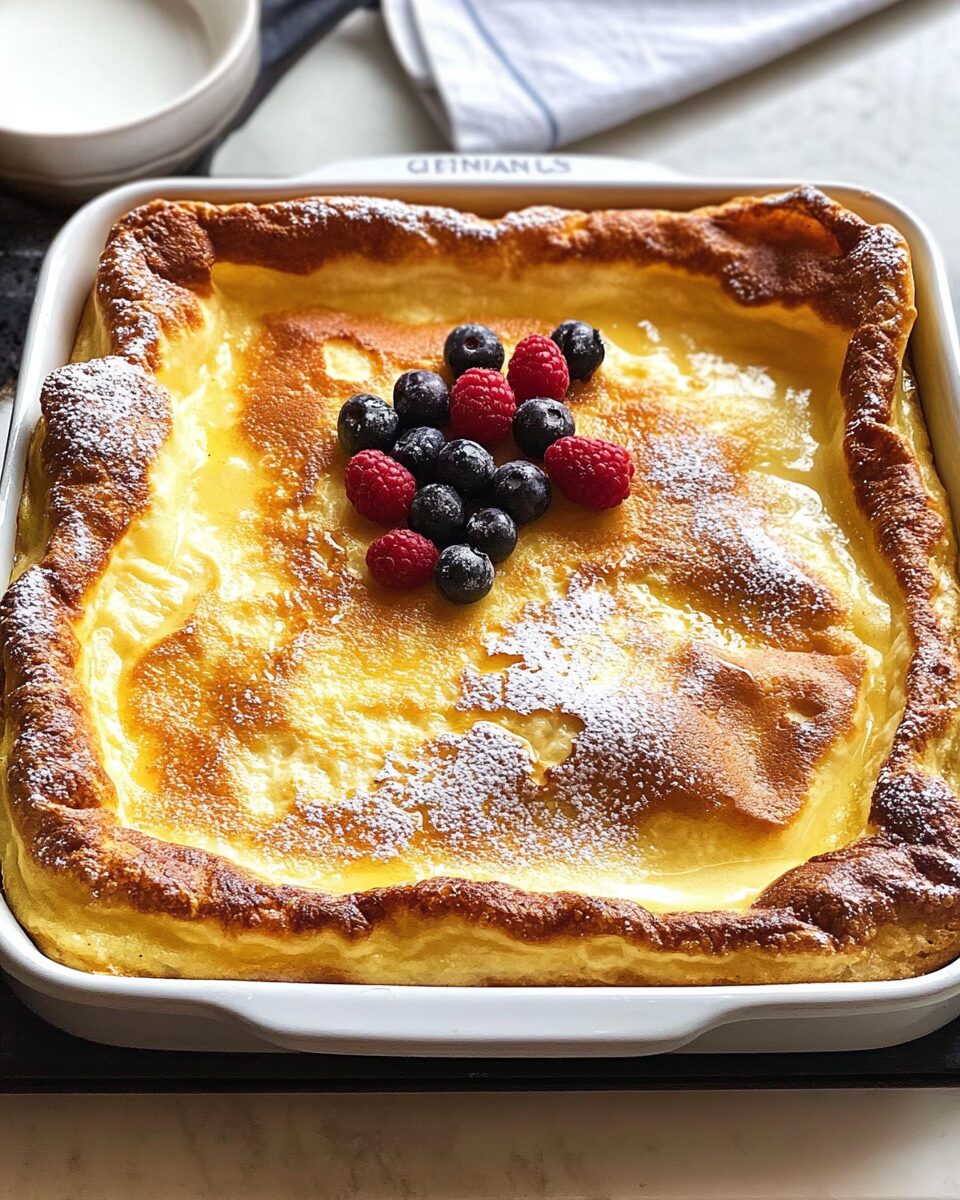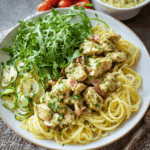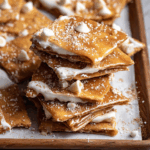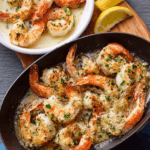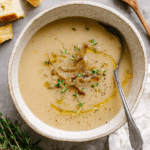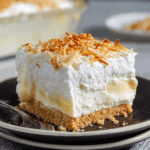The Baked German Pancake, also known as a Dutch Baby, is a breakfast masterpiece that magically puffs in the oven to golden, crispy-edged perfection. With a tender custardy center and just the right touch of sweetness, it’s a showstopper made with humble ingredients.
Best of all, it’s endlessly customizable top it with seasonal berries, whipped cream, or a drizzle of rich maple syrup. Whether you’re hosting brunch or just want to elevate your breakfast game, this baked beauty will impress every time. The aroma, texture, and flavor all work together to create something truly special.
Full Recipe:
Ingredients:
-
3 large eggs
-
2/3 cup whole milk
-
2/3 cup all-purpose flour
-
1/4 teaspoon salt
-
1 tablespoon granulated sugar
-
1/2 teaspoon vanilla extract
-
2 tablespoons unsalted butter
-
Fresh berries, for topping
-
Powdered sugar, for dusting
-
Maple syrup, for serving
Directions:
-
Preheat your oven to 425°F (220°C).
-
Place a 10-inch cast-iron skillet or oven-safe pan in the oven to heat.
-
In a mixing bowl, whisk together the eggs, milk, flour, salt, sugar, and vanilla extract until smooth and lump-free.
-
Once the oven is hot, carefully remove the skillet and add the butter, swirling to coat the pan evenly as it melts.
-
Pour the batter into the hot skillet and immediately return it to the oven.
-
Bake for 15-18 minutes, or until the pancake is puffed up and golden brown around the edges.
-
Remove from oven and let it slightly deflate.
-
Top with fresh berries, dust with powdered sugar, and drizzle with maple syrup.
-
Slice and serve warm.
Prep Time: 5 minutes | Cooking Time: 18 minutes | Total Time: 23 minutes
Kcal: 230 kcal | Servings: 2 servings
The Ultimate Guide to Baked German Pancakes (Dutch Baby)
There’s something magical about a Baked German Pancake, often lovingly referred to as a Dutch Baby. From its dramatic puff in the oven to the lightly crispy, golden edges and soft, custardy center, this humble dish transforms simple pantry staples into a truly memorable breakfast or brunch experience. Whether you’re serving it as a morning treat, a weekend showstopper, or even a light dessert, this recipe never fails to impress.
A European Classic with American Popularity
Despite the name, Baked German Pancakes are more often associated with American brunch tables than actual German cuisine. The dish traces its origins back to German immigrants who brought similar egg-based recipes to the United States. The name “Dutch Baby” is said to have originated from a corruption of “Deutsch” (meaning German), coined in the early 1900s by a Seattle restaurant.
Over time, the Dutch Baby became a beloved brunch staple, especially in the Pacific Northwest, where it gained popularity for its theatrical puffing and customizable toppings. While it’s similar to a Yorkshire pudding or popover, the Dutch Baby is slightly sweeter and typically served with fruit, syrup, powdered sugar, or lemon juice.
Why This Pancake Stands Out
Unlike traditional pancakes that are flipped on a griddle, a Dutch Baby is cooked in a preheated oven, allowing the batter to rise dramatically. The oven’s intense, even heat creates the iconic puffed-up edges that collapse slightly after baking but retain a light, airy texture inside.
The simplicity of the ingredients eggs, flour, milk, and a few flavorings makes it incredibly versatile. The batter comes together in minutes and doesn’t require any leavening agents like baking powder or baking soda. The rise comes entirely from the steam created by the high oven temperature, making it a culinary experiment as much as a dish.
The Role of the Skillet
A cast-iron skillet is the gold standard when it comes to baking German pancakes. Its ability to retain and evenly distribute heat is essential for getting the signature puff and crisp edges. If you don’t have a cast-iron skillet, any oven-safe skillet or even a baking dish with tall sides can work, though results may vary slightly.
Preheating the pan before adding the batter is critical. The moment the cold batter hits the hot buttered skillet, it begins to cook and steam, triggering the rise that gives the pancake its airy texture and signature look.
Topping Variations and Serving Suggestions
One of the most exciting aspects of a baked German pancake is how adaptable it is to different flavor profiles. While berries, powdered sugar, and maple syrup are classic choices, there are dozens of ways to dress it up:
-
Fresh Fruit: Strawberries, blueberries, raspberries, sliced bananas, or stone fruits like peaches and plums.
-
Sweet Sauces: Caramel drizzle, chocolate syrup, fruit compote, or even lemon curd.
-
Savory Twists: Omit the sugar and vanilla in the batter and top with smoked salmon, crème fraîche, or sautéed mushrooms and herbs.
-
Spiced Sugar: A sprinkle of cinnamon sugar or nutmeg over the top adds warmth and depth.
-
Nutty Crunch: Toasted almonds, walnuts, or pecans can offer contrast in texture.
Traditionally served warm, Dutch Babies are best eaten fresh out of the oven. While leftovers can be stored and reheated, the pancake loses some of its magical puff and texture once it cools.
Nutritional Value and Customizations
With only a few main ingredients, a Dutch Baby is relatively low in calories per serving compared to more decadent brunch options like cinnamon rolls or French toast. It’s rich in protein thanks to the eggs and can be made more nutrient-dense by incorporating whole wheat flour, almond flour, or dairy alternatives like oat milk or almond milk.
For those with dietary restrictions:
-
Gluten-Free: Use a 1-to-1 gluten-free flour blend.
-
Dairy-Free: Swap the milk for plant-based options and use dairy-free butter alternatives.
-
Low-Sugar: Skip the sugar in the batter and rely on naturally sweet toppings like fruit.
Common Mistakes and How to Avoid Them
Though simple, there are a few tricks to getting this pancake just right:
-
Cold Ingredients: Use room temperature eggs and milk to help the batter puff properly.
-
Skipping the Preheat: Always preheat both the oven and skillet this is crucial to the rise.
-
Overmixing: Blend the batter until just smooth; overmixing can cause a dense texture.
-
Opening the Oven: Avoid opening the oven door during baking; temperature drops can deflate the pancake prematurely.
-
Too Much Topping Too Soon: Don’t top the pancake before it’s baked. Add toppings after it comes out of the oven to avoid soggy results.
Perfect for Any Occasion
One of the most delightful aspects of the Dutch Baby is how it effortlessly transitions from casual to elegant. It’s easy enough for a lazy Sunday morning yet fancy enough for a brunch party or special celebration. Kids love it for its puff and sweetness, while adults appreciate its light texture and gourmet appeal.
Serve it with coffee, tea, or a mimosa, and pair with sides like crispy bacon, sausages, or a fresh fruit salad. Its versatility makes it a blank canvas for any seasonal theme from bright citrus in spring to warm cinnamon apples in fall.
A Delicious History with a Bright Future
What began as a regional specialty has now become a beloved staple in kitchens around the world. Thanks to its ease, elegance, and endless variety, the Baked German Pancake is here to stay. Food bloggers, chefs, and home cooks alike have embraced the Dutch Baby for its unique blend of drama and simplicity.
If you’ve never made one before, don’t be intimidated it’s almost foolproof. With just a little preparation, you’ll be rewarded with a stunning, golden pancake that’s sure to draw oohs and aahs from anyone lucky enough to share your table.
Conclusion:
The Baked German Pancake is a reminder that sometimes the simplest ingredients yield the most extraordinary results. It’s a recipe that invites creativity, welcomes personalization, and rewards both new cooks and seasoned chefs with a dish that feels special every single time.
Whether sweet or savory, minimalist or decadent, the Dutch Baby holds its own as a culinary gem in the breakfast and brunch world. Try it once, and it’s sure to become a permanent part of your kitchen repertoire.

